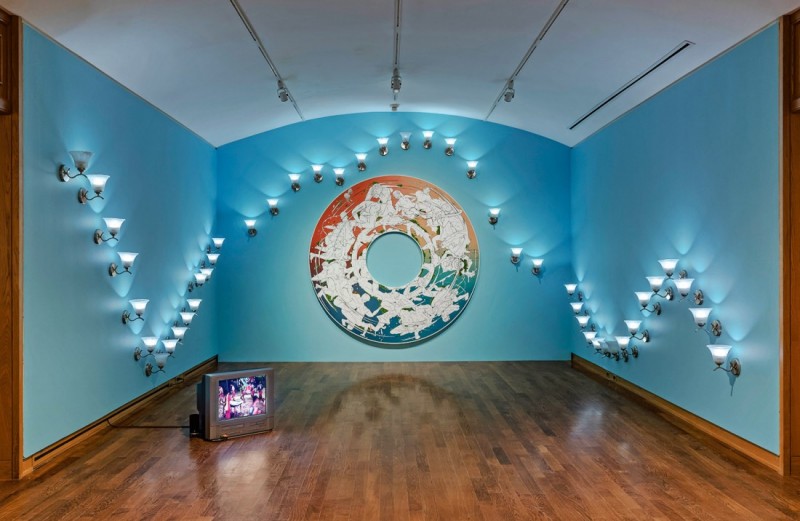The Unblinkered Vision
In 1952 Akbar Padamsee, a 24-year-old painter from Bombay, was awarded an art prize by André Breton in Paris for his painting Woman with Bird. It was a signal event in a life that took him back to India, where he set about to create a dialogue between artists in his country and the international avant-garde. From 1969 to 1972 in Delhi and Bombay, he established the Vision Exchange Workshop (VIEW) to further that interdisciplinary conversation. It met with mixed results in India, but his naming and vision have been picked up in Canada by curators Catherine Crowston from the Art Gallery of Alberta and Jonathan Shaughnessy from the National Gallery of Canada for “Vision Exchange: Perspectives from India to Canada,” an exhibition that opened last September at the AGA and that is currently on view at the Art Museum at the University of Toronto, where it will remain through March 23 of this year. (It will then tour to the Winnipeg Art Gallery, the MacKenzie Art Gallery in Regina and the National Gallery in Ottawa until 2020.)

Reena Saina Kallat, from the series “Hyphenated Lives,” 2015-16, mixed media on handmade wove paper, dimensions variable. Photo: Toni Hafkenscheid. Courtesy the Art Museum at the University of Toronto, Toronto.
The perspective that “Vision Exchange” makes clear is that exchange is critical in understanding the state of global modernism. In the case of India, it offers a vision that is a revelation. Padamsee is only one of the artists in this important exhibition who understood the intersections of modern art. The familial exchange reimagined in “the photo-dream love play” involving Umrao Singh Sher-Gil, his daughter, the painter Amrita Sher-Gil, and her nephew, Vivan Sundaram, is dazzling. The original photos and their “reconstitutions” as digital photomontages present a captivating world of sophisticated elegance and sensuality.
Evidence of various degrees of sophistication is hardly a modern recognition. The 2017 wool carpet with metalized thread from the Raqs Media Collective included in the exhibition is called The Necessity of Infinity, (Based on a 10th Century correspondence between Al Beruni and Ibn Sina). It reminds us of the profound influence their metaphysics had on the philosophy of Thomas Aquinas and is an indication that the exchange between East and West has been going on for centuries. The works in the exhibition often underline our incomplete appreciation that the dialogue had two sides. In Ashim Ahluwalia’s Events in A Cloud Chamber, a poetic meditation on Padamsee’s 1969 lost film, we learn that the woman who composed the music for his original film, Gita Sarahbai, was a significant influence on John Cage.

Jiten Thukral & Sumir Taga, Farmer is a wrestler , 2018, oil on canvas, video and light fixtures. Installation view. Courtesy of the Artists, Nature Morte, New Delhi, and the Art Museum at the University of Toronto, Toronto.
Among the important functions this exhibition performs is to un-blinker our narrow and exclusionary vision of India; it is part of a necessary reframing of the historical narratives we have inherited. What we see through that expanded frame is a layered culture that maps the complex history of India since the Partition in 1947 through to the present. Mapping becomes important because it is a mechanism for representing land and geographies. So Bharti Kher’s 2018 series “Points of Departure” shows paper cartographies comprised of bindis, the third eye through which women see the world; and Sarindar Dhaliwal softens the rupture of the Partition through her marigold remapping of the Indian subcontinent. When the land comes into focus, as it does in Farmer is a wrestler, 2018, by Thukral and Tagra, it takes the form of an installation that includes painting, light fixtures and a video. The irreverent, over-the-top quality of their presentation is an indirect way of dealing with the crisis of suicides among Indian farmers. The wrestle is a complicated one, and the unpredictable and surprising way that it is imagined is characteristic of the insights offered by the “Vision Exchange.”
Both curators admit the exhibition has opened up a number of possibilities for furthering the exchange and suggesting how that vision might be extended into the diaspora. “We could have included more Canadian artists,” Crowston says and then adds, “but that will be show number two.”

